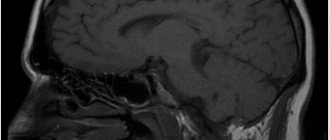The essence
The main reason is the discrepancy between social and everyday circumstances and the child’s changing needs. He wants to be an adult, he even feels like one. However, a huge number of restrictions, rules and demands from parents do not allow him to fully demonstrate independence. This causes an internal protest, which results in emotional and behavioral deviations that frighten parents so much.
The three-year crisis is characterized by the following mental neoplasms:
- primary independence;
- a new level of self-awareness;
- establishing interpersonal contacts, building new, more complex social relationships;
- volitional regulation of activity.
Developmental psychology helps to understand what is happening to a child during this period. It allows you to understand the factors that aggravate or alleviate the crisis, and gives recommendations on how parents should behave in order to prevent negative consequences.
Educational program. You can learn in detail about this period from special literature on psychology: Vygotsky “The Crisis of Three Years”, Guskova “Features of the Crisis of 3 Years in the Mental Development of a Child”, Vasilkina “What to Do if a Child Has a Crisis of Three Years?”, Abrosimova “The Age of Obstinacy. About the crisis of three years”, Filicheva “The baby is three years old”.
Early affective development of children with autism
After a year and a half, closer to two years, the trends outlined above become more and more obvious.
- Difficulties in arbitrarily organizing his behavior remain and naturally increase in situations of increased demands on the part of parents : it is difficult to attract attention, distract from a random impression, switch to some actions proposed by adults, and introduce the necessary prohibitions. It seems that he does not hear the appeal, at least he may not respond to it. Imitation of close adults and children is not formed, although selectively the baby can imitate any mechanical sound or copy the bright action of a character in a favorite cartoon or advertisement. His manipulations with toys do not become more complicated (and in some cases they do not attract his attention) - he does not learn to play, but continues to stereotypically throw around or, conversely, carefully arrange cars, cubes, pencils in rows, spin wheels, or simply constantly hold in your hands some preferred objects (boxes, sticks, strings, etc.).
- The delay in speech development and its originality becomes more pronounced : the child may not acquire an active vocabulary and may not respond to speech addressed to him; babbling, individual words, phrases, and in some cases complex “adult” phrases that are not age appropriate may appear, but they are not in the nature of an address, are not aimed at communication, and their connection with the real situation is not always clear. It is possible that “one’s own speech” may appear—some peculiar sound combinations, syllables, mutterings that accompany the child’s stereotypical activities and are not addressed to others (in these cases we can talk about autostimulation, especially when the child makes specific sounds that are not characteristic of the phonemes of the native language, reminiscent of chirping, clicking, creaking or high-pitched vowels, guttural sounds, etc.).
- Interest in peers does not develop (the child either “does not notice” them or is afraid and tries to stay away).
- Unusual stereotypical movements or actions with objects become noticeable , which intensify in situations where the child experiences some strong impression (both positive and negative).
- Severe behavior problems appear and intensify (anxiety, fearfulness, fears, self-absorption, which can be combined with periods of increased excitability, disinhibition; negativism; aggression and self-injury; noticeable difficulties in accepting everything new, including the appearance of serious restrictions in food, difficulties changing clothes, changing the walking route, etc.)
With successful development at this age, an ordinary child also strives to repeat and maintain the habits that have developed in his daily interactions with loved ones; he, too, can become stubborn and demonstrate protest through aggression and whims; and normally during this period parents begin to notice the first fears (including night fears). However, these age-related behavioral characteristics do not prevent the development and complication of the child’s emotional interaction with loved ones. A mother can calm a frightened baby, persuade him, distract him, and interest him in something new.
When there are signs of a severe disturbance of emotional development, the child is particularly susceptible to developing affective discomfort (a direct sign of which is self-injury), and his extremely long-term fixation on negative impressions. At the same time, the baby may not complain, not turn to his mother for help and, on the contrary, further isolate himself from contact with loved ones and resort to his own methods of calming down (at these moments, special motor discharges, rocking, covering his ears with his hands may appear).
Let us take a closer look at the most characteristic behavioral problems of an early age and their distinctive features in the emerging autism syndrome.
Fears
The specificity of fears in autistic dysontogenesis lies not so much in their content (although clinical studies traditionally speak of the inadequate nature of fears), but in their intensity and strong fixation. Once arising, each fear remains relevant for the child for many years. Fears that sometimes seem absurd and unreasonable (for example, your own bare foot sticking out from under a blanket, an open umbrella, or a hole in tights) become more understandable if you remember how sensitive an autistic child can be to a violation of the completed form. The ease of fear arising is, of course, also associated with the special selective sensitivity of such a child to sensory impressions of a certain modality (sound, tactile, visual, gustatory, olfactory), when the intensity of certain stimuli subjectively increases.
But the most characteristic fear is the fear of change: violations of the usual living conditions and patterns of behavior of loved ones are perceived by such a child as an existential threat.
Aggression
Aggression is one of the most common behavioral problems that arise early in a child with emotional development disorders.
The causes of aggressive manifestations and the forms of their expression can be varied. For an early age, generalized aggression is especially characteristic, arising against the background of the child’s excitement, provoked by too strong experiences (including positive ones). This tendency can also be observed with completely successful development, when, for example, a naughty baby begins to scatter, scatter, trample everything, or suddenly runs up and hits or bites his mother, or, overly excited from noisy fuss with other children, hits a nearby child or throws him in him with something. In the case of difficulties in affective development, when there is a particular ease of satiety, and, consequently, the rapidity of the development of an initially positive impression into a negative one, this tendency is especially pronounced.
Another common cause of aggression is a protest reaction. Just like autostimulation that shields unpleasant external influences, it performs a protective function in this case. An autistic child protests, first of all, against exceeding the level of interaction available to him with others and violating the stereotypical conditions of his existence. At the same time, the child’s aggressive actions can be directed both at a loved one and at himself (he can bang his head, knock himself on the head, bite his hand). It is characteristic that with a symbiotic attachment of a baby to his mother, physical aggression towards her more often occurs when the child feels threatened by the loss of her stability and reliability (for example, when she is very upset, crying or irritated). Aggression can also manifest itself as attraction: the desire to grab the hair, press the chin into the shoulder of an adult.
Negativism
With successful development, a child, as is known, experiences a stage of special flourishing of negativism during the “three-year crisis”, the content of which is the defense of one’s own “I”. The manifestations of negativism observed in an autistic child of a similar age are qualitatively different. Most often, they reflect not his protest against the suppression of his independence (due to the pronounced delay and difficulties in forming ideas about himself, such manifestations arise much later), but the same constant desire to preserve the immutability of the environment and his limited forms of interaction with it.
A child’s refusal to fulfill some of the everyday demands of loved ones, which naturally arise when trying to develop his basic skills (eating independently, dressing, toilet training), is associated, as we noted, not only with the real difficulties of voluntary organization and imitation, but also with the frequently occurring the extreme discomfort and fear that he experiences in these situations. Often the cause of negativism is the child’s special dependence on the direct influences of the surrounding sensory field: it is difficult for him to break away from some exciting impression, interrupt an unfinished action, etc. The problems that arise in such situations are characteristic of normal ontogenesis at one year of age. In the case of autistic developmental tendencies, they acquire a particularly acute and enduring character.
There may also be signs of developmental regression , when the minimum of emotional connections, forms of contact, and skills (including speech) that the child began to acquire before he learned to walk are lost. Thus, in a number of cases, parents noted that by the age of one and a half years the child had developed elements of imitation (he played “okay”, waved his hand when saying goodbye, pretended to say “what a dog or kitty says,” hugged his mother), that the child selectively started something show in pictures (more often point with your hand and wait for the adult to say the name) that sometimes he asked to go to the potty (at least you could guess his desire), but all these achievements were very weakly expressed, unstable and, without having time to gain a foothold, disappeared . This trend does not correspond to what normally happens to a child of a given age, in whom, after a period of pronounced “falling into field dependence,” initial household skills may also temporarily weaken and even disappear. After one and a half years, against the background of the active development of imitation, their intensive formation is noted. Regressive signs in autistic dysontogenesis are usually combined with increasing behavioral problems (severe discomfort, anxiety or depression, fears) and vital disturbances (primarily serious sleep disorders).
All of the above features of the relationship of an autistic child with the outside world and loved ones indicate a disruption in the development of ways to organize active relationships with them. In the development of such a child from an early age, there is a tendency for stereotypical autostimulation activity to prevail over truly adaptive activity.
This characteristic tendency can manifest itself in different ways, which is reflected in the development of various variants of the syndrome by the end of early life. Four groups of autism have been described (O.S. Nikolskaya, 1985), differing in the level of maladjustment of the child, which is manifested by varying degrees of severity of autism and the predominance of various types of autostimulation activity. Let us consider the signs of the formation of each of the variants of the syndrome, identified as a result of the analysis of the developmental histories of children who received a diagnosis of autism of a certain group during the initial examination.
← back 3 forward → show on one page
Causes
The main reason why children experience a crisis at age 3 is the desire for independence. By this age, they already speak well and can clearly and clearly express their desires and emotions verbally. It seems to them that this is enough to be the same as adults: eat what they eat, sit late at night watching TV, swear in bad words. Every action in this little domestic apocalypse will be aimed at achieving independence.
However, the 3-year-old crisis occurs differently for each child. Someone makes the existence of the family unbearable - endless hysterics, uncontrollable aggression, constant protests, complete depreciation of previous rules lead to serious problems. For others, the manifestations are not so vivid: isolated cases of obstinacy, sudden changes in mood, minor whims. It is noticeable that a crisis has arrived, but it is completely controllable. There are also children for whom everything goes smoothly and almost unnoticeably.
Psychologists identify a number of reasons for the intensity and brightness of the crisis of 3 years.
Authoritarian parenting style
If excessively strict norms are established in the family, unconditional submission is required, will and independence are suppressed, this results in prolonged hysterics.
Overprotection
Excessive parental care, like an authoritarian parenting style, suppresses will and independence. A child, even at 3 years old, is considered unintelligent, unviable and completely helpless. They do not allow him to take a single step without the permission of an adult. It is not surprising that the baby will prove the opposite, which will significantly complicate the problem period.
Society
The situation is often complicated due to the authoritarian parenting style or the elementary rudeness of the kindergarten teacher. The company of children with whom he plays in the yard or in kindergarten can have a bad influence on a child. Conflicts with other people force him to defend his independence even more zealously.
Intrafamily relations
The crisis is aggravated if there is a tense atmosphere within the family. Firstly, if the parents often fight or are in a state of divorce. The second psychotraumatic situation is that they are constantly busy at work and have no time to take care of the child. Problems may begin after the birth of the second baby. Childhood jealousy arises, which turns into uncontrollable outbursts of anger. In all these cases, there is a lack of attention.
But older children who participate in upbringing make the crisis easier.
Temperament
An unstable nervous system, excessive impressionability, choleric or melancholic type of temperament is another reason for the worsening crisis of 3 years.
Health status
In healthy children, the crisis period proceeds within normal limits. He is noticeable, but is kept under control by his parents. If a child develops mental abnormalities and disorders by the age of 3, the situation worsens, the manifestations are uncontrollable, vivid and explosive. In the presence of chronic diseases, genetic pathologies, or physical disabilities from birth, children are usually strongly attached to their mother and do not rebel against her. Therefore, they most often do not cause much trouble.
Adaptation to kindergarten is often cited as one of the main reasons for the 3-year-old crisis. Indeed, it is at this age that parents usually send their child to this preschool institution. But there are also children who are assigned there much earlier (from 1.5 or 2 years old). There are kids who don’t go there at all; they stay at home with their mother or grandparents. According to research, in all these cases, by the age of 3, an age crisis occurs, regardless of whether the child attends kindergarten or not and from what age.
Alalia forms
There are several forms of motor alalia. It is customary to distinguish motor and sensory types of diseases. In the first case, the child cannot speak, in the second, he does not understand speech addressed to him. Sometimes vague symptoms occur, in which case doctors diagnose “mixed alalia.”
Alalia is brain damage that prevents a child from speaking.
Motor alalia
Motor (expressive) alalia is a disease in which the part of the child’s brain responsible for speech production is affected. It is located in the left hemisphere. During normal development, a newborn first assimilates non-speech noises: natural, technical, object. They are absorbed by the right hemisphere and become the basis for active speech development.
The task of the left hemisphere is to filter the signs of speech from the sounds collected by the right hemisphere. Non-speech sounds pass through the corpus callosum from one hemisphere to the other and are converted into speech sounds. This forms a speech base and allows the child to learn to speak. But children with motor alalia cannot modify non-speech sounds - they have damage to the part of the brain responsible for this function.
Depending on the severity of the damage, the baby can distinguish sounds and assimilate their semantic connections, but at the same time he is unable to form articulatory movements. If the damage to the cerebral cortex and left hemisphere is not severe and the motor areas are preserved, this ability can be restored.
Depending on the location of the problems, motor alalia can take two forms:
- efferent. Occurs when the premotor cortex is damaged (posterior third of the inferior frontal gyrus, Broca's area). Because of it, the child becomes unable to form a series of movements: he pronounces a single sound, but cannot say a group of sounds. Symptom: distortion of the syllabic structure of a word, getting stuck on one syllable;
- afferent. Occurs when the postcentral zone of the cerebral cortex (lower parietal part of the left hemisphere) is damaged. It causes a disorder in the senses of articulatory posture: the child does not understand whether his mouth is open or closed, what position his tongue and lips are in, or whether there is vibration of the vocal cords. This leads to incorrect pronunciation of some sounds. Also, the baby avoids saying sounds that are too complex in terms of articulation, so he often skips or replaces them with others.
Both types of motor alalia are treated with a set of measures that include both drug therapy and speech therapy sessions.
Symptoms of motor alalia
The symptoms of motor alalia are:
- complete absence of speech after 3 years of life (before this, doctors diagnose “delayed speech development”);
- neurological symptoms: fatigue, unilateral ptosis of the eyelid, shifting pupils, disorder of finger motor skills, difficulty identifying parts, numbers, sides (left-right);
- psychopathological symptoms: deviations in auditory attention, concrete thinking, weakness of attention, underdevelopment of the emotional and volitional sphere, mood lability, excessive gullibility or severe irritability;
- poor posture and asthenicity, problems with coordination of movements, left-handedness due to weakness of the right hand, hyperactivity or immobility;
- speech signs: impaired pronunciation of all groups of sounds, inability to correctly pronounce words, phrases, incorrect use of pitch and strength of voice, impoverished vocabulary, gross violations of grammar (infinitives are especially often used instead of verb forms);
- the discrepancy between active and passive vocabulary is a very clear symptom. The child understands the word and is able to interpret its meaning, but cannot pronounce it.
Early diagnosis of this disease allows you to start treatment on time and make it more effective. If you notice one or more symptoms, do not delay visiting your doctor.
Diagnosis and treatment of motor alalia
With motor alalia, much attention is paid to diagnosis. The problem is that this disease can be easily confused with other speech disorders. The examination should include:
- taking anamnesis, if possible. It allows you to determine the causes of pathology;
- completing various studies. Often prescribed: EEG, echoencephalography, auditory function testing - otoscopy, audiometry; X-ray of the skull, MRI of the brain;
- consultations with an ENT specialist, psychoneurologist, neurologist, psychologist;
- dynamic examination, which begins after correctional work: a specialist looks at the dynamics of speech development and clarifies the diagnosis.
Children with motor alalia must be treated using several methods at once. With the right approach, you can return a child to normal speech in 2-3 years. To do this you need:
- Take medications such as Piracetam, Nootropil, Pantogam, Cerebrolysin, Actovegil, etc.
- Visit a physiotherapy office. Electrophoresis, magnetic and laser therapy, IRT, hydrotherapy, and electropuncture are often prescribed.
- Work with fine motor skills, develop memory and thinking.
- Form a vocabulary, engage in logorhythmic exercises, stimulate speech activity.
It is very important to choose the right drugs based on the degree of brain damage. Also, treatment should be carried out by an experienced speech therapist who is already familiar with the problem and knows how to work with it. Avoid traditional methods: they are ineffective and simply waste your time.
Possible complications and consequences
If time is wasted and children with motor alalia are not treated, they may have significant problems in the future. The most common consequences:
- the appearance of dysgraphia and dyslexia, when a child cannot write or perceive written text correctly;
- the occurrence of stuttering and other disturbances in the functioning of the articulatory apparatus;
- the appearance and strengthening of speech negativism (conscious refusal to speak when the child does not want to use words at all).
Complications significantly complicate the child's integration into society and reduce his learning opportunities.
Speech negativism can be a consequence of other factors. For example, diction is impaired by crooked teeth. Read more about this here: Causes, dangers and treatment of crooked teeth in children and adults.
Forecast
The prognosis and improvements observed during treatment of children with motor alalia depend very much on the degree of damage to brain structures. In many ways, our body is able to compensate for some violations, but this is impossible with extensive lesions. The age at which treatment began also influences, since the older the person, the less likely it is to restore speech function.
The disease has a favorable prognosis: after 2-3 years of regular classes, the child will reach the language norm, compensate for the impairments and get rid of most symptoms.
Prevention
Prevention of alalia must begin during pregnancy. During this period, it is necessary to avoid factors that can damage the speech centers in the child’s brain or cause their insufficient development. You should also not give up breastfeeding without good reasons, conduct regular examinations of the baby and engage in the comprehensive development of the child.
There is no panacea, no magic method that is guaranteed to save you from the development of motor alalia. But the right approach to bearing and raising a baby will help simplify diagnosis at the beginning of life and make subsequent treatment more effective.
Sensory alalia
Sensory alalia is a consequence of damage to the cortical end of the auditory-speech analyzer (Wernicke's center) and its pathways. Because of this damage, the child “does not hear” the words of others, despite good hearing and the ability to develop active speech. The child’s own speech is completely absent, and if it develops, it stops at the level of babbling words. The baby can repeat the word he just heard and remember it for a while. The lack of ability to recognize sounds leads to the fact that the child does not understand speech at all.
Diagnostic methods and symptoms
Diagnosis is carried out using the same methods as for children with motor alalia: the child needs to undergo an EEG, skull X-ray, MRI of the brain, otoscopy, etc. To clarify the diagnosis, you should visit a neurologist, speech therapist, psychologist, otolaryngologist.
The diagnosis is made when several of the following symptoms are observed at once:
- speech is active, children “talk” a lot and with normal intonations, but at the same time the phrases are incomprehensible to others because they consist of fragments of words and meaningless sound combinations;
- connections between heard and spoken words are not formed, the names of objects are not assigned to them;
- the child remembers the word after 20-25 repetitions, compared with the normal 3-5 for a healthy child;
- there is a lack of control over one’s own speech;
- neurological and mental symptoms manifest themselves in increased excitability, weak manifestations of the emotional-volitional sphere and secondary mental retardation.
Often children with sensory alalia exhibit non-standard hearing function. They hear any sounds well, but quickly get tired of them, so they may stop perceiving loud sounds (exhaustion of auditory function). A child can perceive effects of the same frequency and volume in different ways: sometimes he hears them, sometimes he doesn’t hear them. The greater the interval between sounds/words, the better the child recognizes them.
Corrective work of a speech therapist
It is important to understand that the main task of a speech therapist when working with alalik is to turn on the preserved channels of speech activity and make them work actively. There are many techniques for this, which only a specialist can apply correctly. Parents cannot replace a speech therapist.
Classes with a speech therapist for alalia are very important
Treatment options
Sensory alalia is most often treated primarily with medication. But this is not entirely the right approach: a complex influence is needed. The stages of treatment are as follows:
- Selection of drugs. They are needed to improve cerebral circulation and correct behavior (if the child is too passive or too active). It is possible to replace the effects of the pills with traditional Chinese medicine, but this requires a trip to China. In Russia, such treatment is offered mainly by charlatans.
- Working with a psychologist. Moreover, it is needed not only by the child, but also by the family. It is very important to properly build communication between all people involved in treatment.
- Working with a speech therapist. The speech therapist is the main specialist who confirms the diagnosis and begins treatment. It is very important to find a good doctor.
- Finding motivation. Classes are difficult for most children, so it is important that the family supports the child’s success.
- Forming the habit of studying at home. It is important that parents come to understand that treatment does not end at the speech therapist’s office. At home, you need to create conditions for classes, purchase or borrow teaching materials, learn how to use them correctly, and ask your speech therapist for homework. Creative activities for the development of fine motor skills are also important: drawing, modeling, etc. It is possible to connect additional non-standard techniques: hippotherapy, dolphin therapy, etc.
- Overcoming speech negativism and creating the right language environment.
- Development of motor skills through active games, music, dancing, logarithmic activities.
The more options for treatment activities you include and the better conditions you create, the greater the chance of coping with the disease.
Massage technique
Often, with alalia, it is recommended to do a special speech therapy massage. It is necessary not for the development of articulation organs, but so that the child begins to feel them better. But often massage is not required at all: speech impairment is often caused not by problems with the articulatory apparatus, but by other factors.
You cannot perform a massage on your own: it must be done by a specialist who has undergone special training and knows the specifics of working with patients. Massage is also contraindicated in cases of enlarged lymph nodes, viral or bacterial diseases of the oral cavity, blood and vascular diseases, and in some other cases.
Silence mode when correcting sensory alalia
There is a special technique that helps increase a child’s sensitivity to sounds. It consists in creating certain living conditions. The speech therapist recommends that parents organize a quiet hour and a day of hearing rest with some regularity. In the children's room, unnecessary sounds are eliminated for this purpose: TV, computer, tablet. Also, during this time, adults should not talk to the child.
The silence mode is interspersed with the interest mode. The child stops running away from annoying sounds and begins to study them. The speech therapist helps the child identify the subject of sound and recognize speech. The specialist also draws the child’s attention to various emotional reactions, helps them copy and express them if necessary.
Prognosis and prevention
Although motor alalia has a more favorable prognosis, parents of children with the sensory form should not give up. Here, too, the degree of brain damage has a strong influence. Be sure to go through all possible diagnostic options and select medications that help the body compensate for lost functions.
Signs
Parents need to know how the 3-year-old crisis manifests itself in order to distinguish its symptoms from ordinary contextual situations. For example, if a child refuses to go to bed on time, this may be dictated by the fact that he was overexcited before bed, played too many noisy games, or sat in front of the TV for too long. Each case must be considered separately.
Psychologists call the complex of symptoms of a 3-year crisis “seven stars.”
Negativism - “I’m doing it out of spite!”
They give up their own desires that coincide with the demands of their parents. They don’t want to do something just because the initiative comes from an adult. A negative reaction is always targeted and directed not at the content of the request, but at a specific person. For example, a mother calls her child from the street for lunch. Despite the fact that he himself has been hungry for a long time and wants to go home, he refuses to do this just for the sake of confronting his mother.
Obstinacy - “I don’t want to obey!”
Unlike negativism, this manifestation of the crisis is impersonal. It is aimed at the everyday life and daily routine that parents try to accustom their baby to. He refuses to go to bed at the right time or put away his toys.
Stubbornness - “I decided so!”
"Don't want!" and I will not!" without any explanation - the most common signs of a 3-year crisis. Neither persuasion nor threats can overcome them.
Riot (protest) - “I’m tired of everything!”
Similar to previous manifestations of the crisis. However, rebellion is the most terrible of them. Firstly, it includes negativism, obstinacy, and stubbornness. Secondly, it is permanent. The child refuses breakfast or nap every day. Thirdly, it manifests itself most clearly. It comes to uncontrollable outbursts of anger and real hysteria. This is fraught with severe stress and auto-aggression.
Despotism - “Do as I want! I am the master and master!”
They try to manipulate parents with hysterics and tears. This especially affects mothers and grandmothers. They are capricious, scream and even roll demonstratively on the floor, just so that the desire is fulfilled (they bought a toy, let them go for a walk, gave them candy).
Devaluation - “I don’t love you! You are bad!
They are angry at what is dear to them, trying to get rid of addiction. A quiet, well-mannered child may start screaming and behave badly in front of strangers (in public transport, for example). They break their favorite toys. Mom becomes enemy No. 1, they stop listening to her and may even hit her.
Willfulness - “I can do it myself!”
This should not be confused with the desire for independence. It’s one thing when a child tries again and again to tie a shoelace or scramble an egg in a plate, but at the same time he listens to the advice of adults and does not refuse help. And it’s completely different when he gets angry, doesn’t listen to anyone, does everything wrong, pushes his parents’ hand away. This often ends in sad situations: household appliances are turned on without permission, valuables are damaged, a child goes far from home.
These are the main symptoms of the 3-year crisis, which manifest themselves regularly, quite clearly, and most often in a complex manner. They may be accompanied by other emotional and behavioral abnormalities. The latter are not observed in everyone and not always, but they can aggravate and prolong the course of the crisis. These include:
- distance from parents who lose the child’s trust and may even cease to be an authority for him;
- greed: like adults, children want to have something of their own, and they fiercely guard their property;
- harmfulness is the basis of obstinacy, stubbornness and negativism, often due to a hereditary character trait;
- jealousy: the child demands the attention of a loved one 24/7 and does not want to share it with anyone else;
- unreasonable aggression: at 3 years old, the baby still does not understand what is happening to him, and blames others for all his troubles, which leads to fights, scratching, biting.
Parents must understand that for each child the crisis manifests itself differently, but it happens anyway. For some it is smoother and more calm, for others - with daily violent protests and hysterics. If symptoms are not observed before age 4, it is necessary to consult a psychotherapist because this may indicate a developmental delay.
This is interesting. In psychology, a child experiencing a crisis period of 3 years is compared to a novice driver. At first, after passing the exams and obtaining a license, the newly minted driver is careful, follows all the rules, does not exceed the speed limit, and consults with experienced drivers. But he soon gets used to it, which dulls the feeling of fear: he begins to drive recklessly, tests the capabilities of his car, and tries to express himself as boldly as possible behind the wheel. The baby behaves exactly the same way. Until the age of 3, he watches and gets used to it. And then he tries to realize himself and assert himself through protests and violation of all requirements and rules.
Signs of negativism
Signs of negativism include stubbornness, rudeness, isolation, demonstrative ignoring of communicative contact or individual requests. Verbally, this is expressed in constantly depressed, suffering, pitiful conversations, aggressive statements in relation to various things, especially valuable to society in general or the interlocutor in particular. Criticism towards people who speak positively or neutrally in relation to the emphasis of negativism. Reflections on the negative structure of the world, references to works confirming this thought, often distorting the meaning or ignoring the opposite opinion of a similar authority.
Often, a person’s assumption of negativism causes violent denial and a realistic, open-minded, unbiased view of the surrounding reality is declared. This position differs from a consciously pessimistic position in that negativism is not realized. The goal of negativistic perception usually becomes a desired, but subjectively inaccessible sphere, or an aspect that a person needs, but he does not want or is afraid to do wrong, to be condemned for a mistake. Therefore, instead of admitting his imperfection, he blames an external object.
The sign is an unreasonably aggressive reaction of resistance, emotionally charged and quite sharp, unexpectedly quickly gaining development. A person cannot calmly accept, ignore, or rationally discuss a request, topic, or situation. Sometimes the reaction may be aimed at arousing pity, in order to avoid further pressure, then stubbornness can be combined with tearfulness and a depressed state. In childhood, this is capriciousness and refusal to fulfill requests; in older age, this is supplemented by an attempt to justify one’s refusal by the unreasonableness or incorrectness of what is happening.
Deadlines
Parents faced with a 3-year crisis are primarily interested in how long it lasts and when it should normally end. However, this question is too individual to have a clear answer.
Firstly, it can begin at 2.5 years or at 3.5. Psychologists say that the sooner a child is sent to kindergarten, the sooner a crisis occurs. The main thing is that this happens before the age of 4 - then we can talk about the norm of mental development.
Secondly, it can end within 3 months, or it can last up to one year. This depends on the stability of the nervous system, the child’s temperament, the behavior of the parents and outside psychological help.
Thirdly, a short-term crisis period is most often accompanied by bright appearances, while a protracted period is accompanied by calmer ones. This is the norm. But if it lasts more than six months and uncontrollable hysterics occur annually, a consultation with a psychotherapist is mandatory.
What to do
Advice from a psychologist will help parents cope with the 3-year-old crisis.
The most important recommendation is to respect the child’s independence. Allow him to perform some basic actions himself. At the same time, prohibitions must also work, which are strictly forbidden to be violated (possing something into a socket, turning on the iron, taking money, biting). By the age of 3, he should already have feasible household responsibilities. He can clean up toys after himself, wipe off dust, and set the table. Yes, his participation will slow down the process, but believe me: it's worth it. This will make him feel independent and needed. This means that the need to prove your adulthood and independence will automatically disappear.
Additional recommendations:
- Keep calm. Be patient.
- At the moment of whims, switch attention to something else, interesting: watch your favorite cartoon, take a walk, treat yourself to candy. Use gaming techniques.
- Sometimes give the right to choose in minor everyday situations: which cartoon to watch, which fairy tale to read, which juice to drink.
- Scold and punish for some specific action done here and now.
- Analyze what happened. Talk to your child about what he did wrong and why it was bad.
- Adhere to a single parenting style. If mom doesn’t allow you to eat chocolate before dinner, but dad spoils his daughter and allows her to do it, negativity will manifest itself as clearly as possible.
- Show correct behavior by example. Children aged 3 are prone to blind copying. You will achieve nothing if you yourself do what you forbid them to do.
- Spend as much time together as possible.
“10 is not allowed”: a reminder for parents
- You cannot insist on immediate fulfillment of a requirement (request). It is better to let the baby cool down and try again after some time.
- You can't give in to manipulation. Don’t satisfy your child’s every whim just because he’s throwing tantrums—just ignore them.
- You can’t hang “labels”: greedy, boring, harmful.
- You can't physically punish.
- You can't shout.
- You cannot force your help.
- You cannot compare a child with other children.
- You can't give orders.
- You cannot enter into arguments or bickering.
- You cannot use complex terms and categories in a conversation that the child does not understand. For example, appeal to conscience or honor.
There is information about the 3-year crisis in the works of L. S. Vygotsky. But they are more scientific in nature, contain many terms and explain all phenomena from a purely psychological point of view. This period is presented more accessible by Dr. Komarovsky. His thematic videos can help parents overcome children's protests.
3 tips from Dr. Komarovsky
Minimum prohibitions
If a child hears the words “no” and “no” from adults too often, this greatly outrages him, and protest grows inside. He needs at least some partial freedom. Constant prohibitions from all sides infringe on him during such an important period of primary maturation and cause psychological trauma. “You can’t” should be said extremely rarely, but at the same time demand unquestioning compliance. This should be a safe word, a danger signal. This is the only way the baby will realize its importance.
Unified parenting style
Komarovsky pays close attention to this. "No!" All family members should tell the child about the same action: parents, grandparents, uncles and aunts, older children. Otherwise, there will be no awareness of the ban, which will aggravate the crisis.
Persistence of prohibitions
The list of prohibitions should be permanent and not change. If today a child is allowed to stay out late, it is useless to demand that he go home on time tomorrow, according to the schedule.
Corrective role-playing games
"Shop"
The child is in the role of a seller. The parent controls the favorite doll, which in this situation is the buyer. She is capricious, throws everything around, cries, screams, rolls on the floor, demands to give her the goods without money. The child must not only see from the outside how terrible this behavior looks, but also recognize himself in the toy. It is allowed to conclude at the end of the game: “You behave the same way. Do you really think that's good?".
"Family"
Any number of people can play. The child is in the role of one of the parents. His task is to put his baby (this can be any toy or one of the adults) to sleep or feed him. If the game is played in the first half of the day, you can play out the same situation as in the “store”: whims, hysterics, tears. If it’s already late afternoon, everything should be quiet, peaceful, calm. Let him sing a lullaby, tell a fairy tale, shelter him, talk tenderly. As a result, this will have a calming effect on him. He himself will fall asleep faster when the time comes.
"Storytellers"
Parents and their children compose fairy tales, the plot of which is similar to what they live every day. For example, the princess refused to eat semolina porridge in the morning. Because of this, she quarreled with her father-king, he got angry and locked her in a high tower, in which she had to languish without walks and her favorite toys. Or a naughty bunny who ran far into the forest from his mother, got lost, and was almost eaten by a gray wolf. There is no need to draw specific analogies with the child; conclusions, as in the “shop” game, are not drawn. He himself must understand the meaning of the fairy tale and say why such misfortunes happened to its heroes.
What is negativism?
Negativism in psychology is resistance to influence. From lat. “negativus” - denial - was originally used to designate pathological psychiatric conditions, gradually the term moved into the context of behavioral characteristics with a normal psychiatric status, and is also used in a pedagogical context.
Negativism is a symptom of crisis. A characteristic feature of this phenomenon is called unreasonableness and groundlessness, the absence of obvious reasons. Everyday, negativism manifests itself when faced with an influence (verbal, non-verbal, physical, contextual) that contradicts the subject. In some situations, this is a defensive behavior to avoid direct confrontation.
By analogy with its original use, negativism is presented in two forms - active and passive.
The active form of negativism is expressed in actions opposite to those expected, the passive form is a refusal to perform an action at all. Negativism is usually considered a situational manifestation of an episodic nature, but when reinforced, this form of behavior can acquire a stable character and become a personality trait. Then they talk about a negative attitude towards the world, a negative assessment of people, events, constant confrontation even with damage to personal interests.
Negativism can be a sign of age-related crises, depression, the onset of mental illness, age-related changes, and addictions.
How a manifestation of a negative attitude can be transmitted at the verbal, behavioral or intrapersonal levels. Communicatively – verbal expression of aggression and disagreement, refusal to do the required or demonstrative doing of the opposite, in the case of a behavioral form. In the deep version, there is resistance that is not transmitted externally, when, for objective or subjective reasons, the protest is limited to internal experiences, for example, if a person is dependent on the object exerting the influence. This form can sometimes be expressed in demonstrative silence. Manifestations can relate to society in general, a separate group or individuals. It seems to a person that they suppress individuality and there is a desire to do the opposite.
Negativism is also possible in relation to the perception of life. The personality perceives life itself, its organization as such, as forcing the individual to obey its laws, to become a “typical representative.” Existence itself is characterized as a problem, a conflict, a lack. This manifests itself as a constant criticism of the world order at different levels from the global to everyday situations. In extreme terms, a complete rejection of social realization is possible as a way of resisting suppression.
Professional help
If parents are unable to cope with the manifestations of the crisis on their own, they should seek help from a specialized specialist. For starters, it could be a child psychologist. What warning signs indicate such a need:
- fear of independence and refusal of it;
- detachment from parents;
- tendency towards sadism;
- too frequent and prolonged tantrums;
- emotional and behavioral deviations characteristic of the 3-year-old crisis affect the physical condition.
In case of intense, frequently recurring hypobulic seizures (hysterics or convulsions), the child is referred to a neurologist who conducts a physical examination. It evaluates reflexes, sensitivity, coordination, muscle strength and tone. This is necessary for the differential diagnosis of a crisis with neurological diseases.
If a neurological or mental disorder is diagnosed, a course of treatment is prescribed with the use of pediatric sedatives and other treatment methods. In their absence, a psychocorrection program is implemented to overcome the crisis. It usually consists of the following steps:
- Working with parents: explaining to them the essence of the 3-year-old crisis and recommendations on how to behave.
- Working with factors that aggravate and alleviate the crisis. The former are eliminated whenever possible, and emphasis is placed on the latter.
- Working directly with the child. This can be fairy tale therapy, dance movement therapy, isotherapy, symbol drama, role-playing games, etc.
Usually the matter is limited to 5-6 sessions, as a result of which the child becomes calmer, and parents acquire knowledge of how to behave correctly in critical situations.
First meeting. 2 – 3 years
We most often encounter childhood negativism for the first time when our children are between two and three years old. Many have heard about the so-called three-year crisis. And the first manifestations of negativism are directly related to this difficult period.
For what?
Why does a baby, who was so easy-going just yesterday, suddenly begin to become stubborn out of nowhere?
This is how he defines the boundaries of his personality: he tries to understand what he, and not his parents, wants or doesn’t want, what he himself likes or doesn’t like. For this reason, any proposal from adults, even the most tempting one that would have recently caused delight, is met with hostility. After all, the little one is sure that they are trying to impose someone else’s opinion on him!
How does this manifest itself?
During this period, a typical manifestation of stubbornness looks like this: you offer to go have tea and pie, but the child angrily refuses. Then you calmly agree: “Okay, if you don’t want to, don’t drink.” But this also causes protest in the baby. What's happening? It’s all very simple: it is important for a child that in a dispute the initiative is in his hands.
What to do?
Is it possible to help a stubborn little one feel that he is the one in control of the situation, but at the same time not follow the lead and not undermine your parental authority?
Psychologists and teachers unequivocally say yes. And they give some advice.
First, make sure that the child is not experiencing physical discomfort.
If the baby is cold, hungry, thirsty, or urgently needs to go to the toilet, then negativism will be especially pronounced. This is the connection between psychology and physiology. Therefore, we will first take care of satisfying all needs.
Stubborn people of such a young age should not be crushed by logic and iron-clad argumentation, but should be captivated by the game.
Forget about arguments like: “You need to walk to be strong and healthy.”
Involve your child in a competition or game: “Who can get dressed faster and run to the elevator?”, “Come on, as if we are grasshoppers and don’t know how to walk, but only know how to jump? Will you and I be able to gallop to the site like this?”
Give your child time to think, do not rush to answer.
Let him think as much as he needs, don’t give any hints, don’t ask leading questions. Otherwise, the baby will get a new reason for stubbornness.
You feel that the baby is flying into a rage and is about to proudly answer “No!” to any questions and refuse any offers? Use such a well-known and very effective technique as alternative questions.
“Where do you want to go for a walk: to the park or to the playground?” “Choose which mittens you will wear: blue or patterned?”
Keep in mind that you must agree to what your child chooses. Therefore, always offer real options, and not those whose implementation will cause a lot of difficulties. If you provide a choice of dishes for dinner, then when offering dumplings or fried potatoes, keep in mind: you will have to cook exactly what the baby preferred.
Determine for yourself a clear range of issues and situations in which you will insist on your own. Otherwise, respect for the child’s opinion will gradually result in complete indulgence. And nothing good will come of this.
In our family, for example, we do not discuss safety issues (whether or not to wear a seat belt in a car, for example), responsibilities such as attending kindergarten, health and caring for it (we must take medications, carry out the necessary procedures, dress strictly for the weather).
In such matters, parents must be persistent and unshakable. But unprincipled situations can be discussed. Thanks to this, the baby will know that his opinion is listened to, and cases of stubbornness will become less frequent.
You can’t turn the situation around, but your persistent child stubbornly repeats his “No!”? Then you yourself will fall into a similar state. Also be capricious and refuse everything your child says.
Try to “mirror” his behavior, you can even fall to the floor and beat him with your hands and feet, filling the apartment with screams. This method usually helps to surprise the child and knock him off the “wave” of negativism, making further negotiations possible.
If the child answers “yes” to at least one question, even if it does not relate to the subject of the dispute, then this is already a big victory and a turning point in the conversation. As a rule, after this the stubborn little guy calms down a little. Therefore, if the child is stubborn, ask him “off-topic” questions, for example, about his favorite cartoons, games, dishes, etc. The main thing is that the baby can answer this question: “Yes!”
Gender characteristics
When overcoming the crisis period of this age, parents should take into account the gender characteristics of their children.
Girls
By the age of 3, they speak much better than boys, so during a crisis they use their verbal abilities for manipulation. In this they must be immediately limited: clearly define what is permissible to say and what is not.
Girls have well-developed auditory perception, so she needs to say all requests loudly and clearly.
Girls are more emotional, which is why they are the ones who most often throw tantrums and act up during a crisis. Given this psychological feature, parents need to direct their overwhelming emotions in the right direction. For example, delegate some of the household chores, get involved in modeling or drawing.
Boys
By the age of 3, boys cannot always express their overwhelming emotions in words. Therefore, they result in aggression and isolation. To prevent this, talk to your baby every day about what happened, what he feels and what he wants.
Boys have well-developed visual perception, and they ignore half the information. Therefore, it is better to show him everything clearly. Don’t waste time saying “Put the toys away!”, but bring them to them and show them where to put them.
By the age of 3, boys already develop a need to explore the world around them. Therefore, they run around a lot, look into every basement and open hatch, climb trees and fences, put something in sockets, disassemble (= break) household appliances. To avoid injury, parents must clearly define territorial restrictions for them.
Consequences
According to the famous psychoanalyst Erik Erikson, the crisis of 3 years contributes to the formation of independence and strong-willed qualities. And these are not the only positive consequences, among which can also be noted:
- primary independence;
- adequate self-esteem;
- ability of self-analysis;
- social adaptation.
However, with insufficient attention and incorrect behavior of parents, as well as due to the psychological problems of the child himself, the crisis can have negative consequences. Firstly, frequent and too impulsive tantrums can result in injury and cause quite deep stress. Secondly, due to internal experiences and excessive emotional stress, the following often develop:
- neurotic reactions;
- enuresis;
- internal complexes;
- night terrors, nightmares;
- stuttering.
A protracted childhood crisis leads to the formation of a hysterical personality type. Its characteristic symptoms become permanent patterns of behavior.
The age crisis of 3 years is a mandatory stage in the development and formation of a full-fledged personality. It cannot be avoided or cured like any disease. But parents are able to smooth out and minimize the negative consequences. To do this, you will have to be patient and understand child psychology.









